Brian Leonard
bleonard@rcmam.com
312-761-2636

Brian Leonard
bleonard@rcmam.com
312-761-2636

First Glance:
Quiet report with no real changes made in production. The dark cloud over the market of tariffs was not addressed in a major way in this report as the demand picture remains blurred by how long the trade war could last. Nothing from the report changes the trade in a meaningful way for corn, soybeans or wheat.
Corn 24/25 US Corn Stocks: 1.540 BBU (1.516 BBU Estimate)
24/25 World Corn Stocks: 288.94 MMT (289.93 MMT Estimate)
24/25 Brazil Corn Prod: 126 MMT (126.07 Estimate)
24/25 Argentina Corn Prod: 50 MMT (49 Estimate)
Beans 24/25 US Bean Stocks: 380 MBU (379 MBU Estimate)
24/25 World Bean Stocks: 121.41 MMT (124.56 MMT Estimate)
24/25 Brazil Bean Prod: 169 MMT (169.18 Estimate)
24/25 Argentina Bean Prod: 49 MMT (48.88 Estimate)
Wheat 24/25 US Wheat Stocks: 819 MBU (797 MBU Estimate)
24/25 World Wheat Stocks: 260.08 MMT (257.62 MMT Estimate)
Overview:
A quiet report as the market looks elsewhere for news to dictate trade. As China gets involved in the tariff war with Canada and Trump steps up tariffs on some imports while delaying others, there remains more questions than answers. News from the White House will be the main market mover moving forward until the planting intentions report at the end of the month. While South American weather is not a problem currently that is always a variable to keep an eye on as their second crop begins to take shape.
Note from the report: “The WASDE report only considers trade policies that are in effect at the time of publication. Further, unless a formal end date is specified, the report also assumes that these policies remain in place.” This is important because US tariffs on Canada and Mexico were delayed until April 2 on all products covered by the USMCA meaning theses numbers are estimates if this is resolved before then.

Equity Markets
The equity markets have given up all gains since the election in November as trade wars and tariffs dominate the headlines with the chip stocks and market leader Nvidia getting hit hard as recession fears ramp up. The global markets, after lagging the US markets for several years coming out of Covid, have ramped up recently, having a better start to 2025.
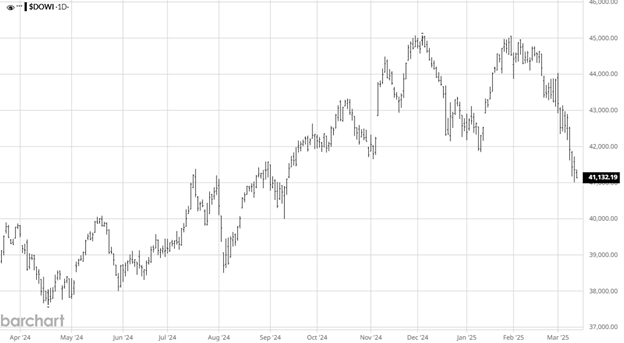
Other News
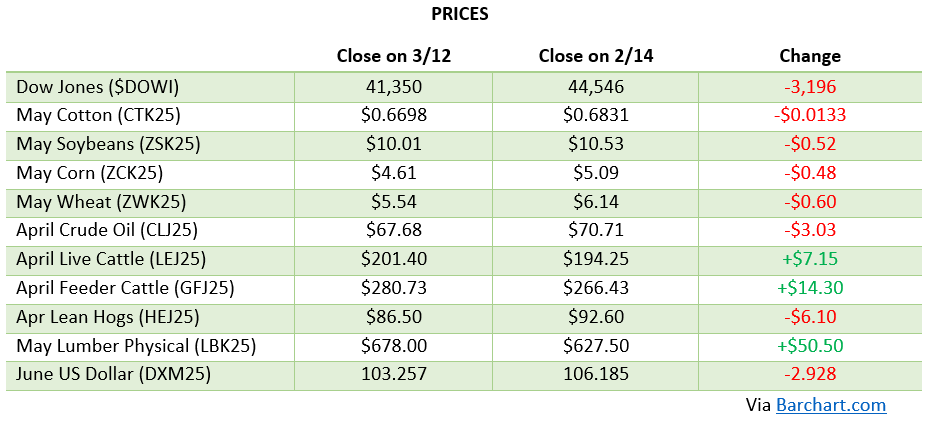

“Lumber, lumber, we don’t need no stinkin lumber.” Or is it, Badges? Trump is coming after the Canadian lumber industry with both barrels. The problem is the current Canadian government does not like or support the industry so who’s on their side? The biggest and very unintended consequence of all may not be sharply higher prices but a real slowdown in the US housing sector. It is already fighting just to stay flat. This may just send investors to other markets, thus reducing the dollars available in the housing sector. You cool the housing sector, and you will cool inflation. Again unintended.
This is one of those times where you plan for the worst and hope for the best. It is also a time when you could have $750 lumber and no customers.
I was dead nuts on last weekend stating that for the market to go higher it would need a sharp sell off. We saw that on Wednesday and keeping to new lumber style, it all happened in a few minutes. That’s how we roll these days. What I missed was the timing. I think we have to take a step back and consider that while the technical read tends to pan out, it now occurs in minutes not days or weeks. We have to project the move and have orders in to take advantage. Don’t freeze on winners. Manage the position based on what the cash market would offer you. More importantly, don’t freeze on losers. Get out.
Sticking with the boxing analogy…. “hit the one in the middle.”
Brian Leonard
bleonard@rcmam.com
312-761-2636

The futures market continued to rally last week. This time, the driver was the fund liquidating shorts. Two weeks ago, it was a substantial cash trade. Last week, it was the roll and liquidation. The cash trade was good last week, but the futures trade was all fund related. On Friday, a mill went off the market, which resulted in nary a ripple in futures. At this point, we need a third catalyst to help the market higher.
Factors to watch:
A slowing Euro supply
Quota information (If the producers get the funds back as usual, this is only a forced savings account and should not be added to the final cost.)
I’m not sure, but I think we went through a day or two without the President calling out lumber. At some point, you will have too much wood or not enough. Those with too much wood can hedge at a premium and wait it out. Those who do not have enough should go back to the old-fashioned way of buying deeply discounted items and running with those until the smoke clears.
Spring… misery loves company, so any consistent warm weather will wake the stragglers up. ( This is not a market factor. Anytime we went into spring bullish, we would find the wood was already bought and delivered.)
The market broke out to the upside of the wedge, which measures $648. I am still in the camp where the market is headed. The issue developing is that this week’s trade shows up on the charts as a big negative. Lumber historically doesn’t creep higher and then explode up. It tends to trade sharply lower for a day or two. Fund liquidation won’t get the market to $648. Adding new shorts will.
If the market sentiment, which is about 95% bullish, can turn down, some higher levels will be hit.
Brian Leonard
bleonard@rcmam.com
312-761-2636


Corn rode the wave higher following the updated USDA numbers in the January report with old crop prices settling into a range and 2025 steadily moving higher. The funds are long 1.8 billion bushels and staying long which is helping this market higher with the general fear being a huge corn acreage number for this year that could present a problem. South American weather remains consistent with non-threatening forecasts while the US has a striking cold few days coming. There are multiple items supporting a continued grind higher from here, but funds have their hand on the scale so keeping an eye on what they do and what the technicals are saying will be important as well as harvest data out of South America. It is never too early to look at making sales for the 2025 crop year once you know your breakeven. You can always look at re-owning it on paper if the market really makes moves higher.


Soybeans have been trading flat since the January USDA Report bump. South America’s record crop present price challenges to the US as we are not the main supplier for the world anymore. A renewed trade war with China would certainly have negative effects again on the soybean market. South America yield numbers and any tariff wars will be the main news in the market until planting begins. Beans inability to continue the rally like corn is not surprising but the corn-bean price ratio that we are seeing is going to make for some interesting conversations when planting is decided.
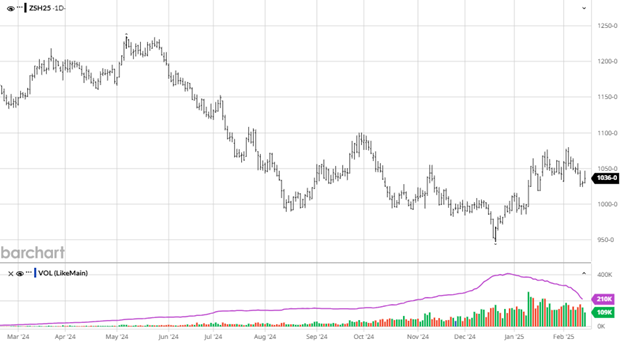

Equity Markets
The equity markets have been volatile as we start the year with the Magnificent 7 taking a break while managers repositioning for expected moves (or lack thereof) from the Fed. With the constant talk of tariffs and then delays to implementation, it provides a volatile market within different sectors.
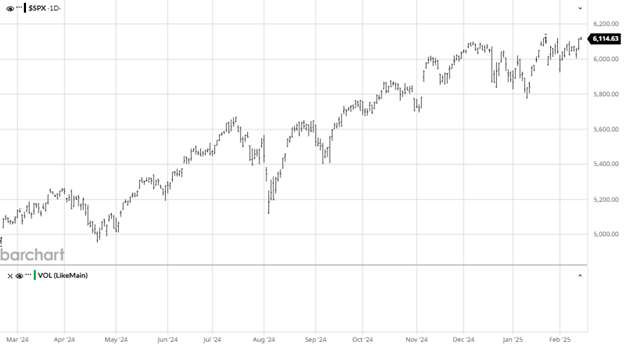
Other News
Drought Monitor
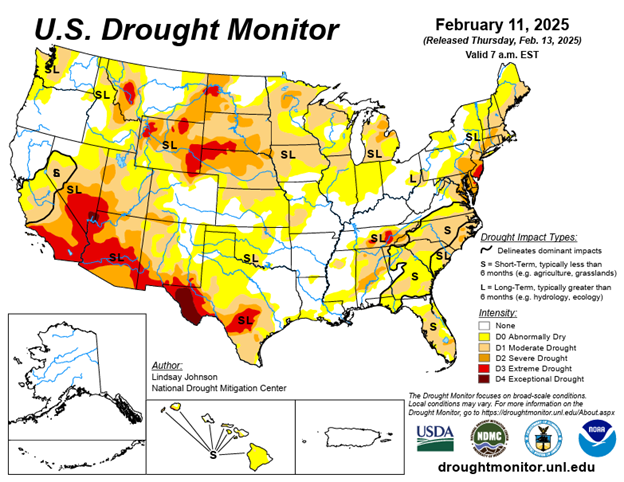

Contact an Ag Specialist Today
Whether you’re a producer, end-user, commercial operator, RCM AG Services helps protect revenues and control costs through its suite of hedging tools and network of buyers/sellers — Contact Ag Specialist Brady Lawrence today at 312-858-4049 or blawrence@rcmam.com.

The dynamic of supply and demand guides most commodities markets. Admittedly some do have a slight amount of emotion added to the trade. Not here. Lumber is different. Most of the trade is based on opinions, emotions, and rumors. Supply and demand factors are secondary. We all know it as a fact and have learned to trade the whole package. This last go-around in futures was a perfect example of the smooth-out cycle that many economists embrace. The thought is pricing smooths out over time. Not in a few hours. While I agree with the theory, I have never enjoyed it in lumber. You are never hedged in this market, and that lack of hedging allows for wide swings. Wide swings kill margins, and reduced margins bring in more caution. Today, everyone wishes for higher prices to bolster the bottom line. A $600 2×4 looks much better on the books than a $400 one. We are seeing a market in the greatest smoothing out period in its history after a run to $1700. It takes time and pain. What a western Canadian producer is at has little to do with the market. Times have changed.
We continue to seek a tighter supply environment to raise prices. This is year three of that strategy. At this pace, the mills could continue to hover around break-even indefinitely. How do we survive in this environment? With SYP and Euro not embracing the cutback strategy, the pool of wood is always available. They always look to sell their wood, which is negative. This leaves the battle between SPF and the marketplace.
There are always chances for a commodity to see sharply higher prices when not warranted. Today, lumber is one. At no time should emotions warrant higher prices when a market doesn’t have the dynamics, but they do.
The trend will be down in the next couple of months as housing stays flat, but prices will spike up and back. The market gives up $30 to $50. Don’t look to add more to it. Trade what it gives you.
Now for today:
The futures market has recovered 50% of this move. 596.30 is 50%, and 61% is 605. Without the algo selling, we could see higher prices, but they will eventually appear. For the next few weeks, the mills will try to dig in. Owning cash today will show a profit.


Recap:
It was a tough week with selling pressure dominating. Who was selling? Most likely an algo that doesn’t grow a position. But I think the bigger question, and one that may linger for a few quarters, is why there isn’t much support on the way down. A quote Friday after existing home sales came out was troubling.
“On an annual basis, existing home sales (4.06 million) declined to the lowest level since 1995, while the median price reached a record high of $407,500 in 2024.” By the way, multifamily construction hit a record last quarter. The industry is very reluctant to participate beyond the contracts that they deal with.
New home sales do better as the existing inventories get sold. Today, with the higher interest rates and record costs, that won’t be happening any time soon. That leaves us in the same atmosphere in 2025 as it was in 2023 and 2024 when the builders created the market. That gives us the duty rally, the tariff rally, and finally, the shutdown/supply rally. At no time does it chase the industry into the marketplace to load up.
If nothing else, the trade is consistent. It made a high and then came back down to value, or at least what the charts call it. We spent a lot of time trading like this at $520. Value is determined by the volume traded in that area. $565 has had a lot. Have we moved our value area from 520 to 560? Too early to tell. The algo type selling strains the market but doesn’t represent it. The industry’s next move will. Just remember, business isn’t dead.
The Leonard Lumber Report is a column that focuses on the lumber futures market’s highs and lows and everything else in between. Our very own, Brian Leonard, risk analyst, will provide weekly commentary on the industry’s wood product sectors.
Brian Leonard
bleonard@rcmam.com
312-761-2636


A lot has happened in the corn market since our last update, from a new administration taking office to a surprise USDA report. The final yield and stocks for 2024 came in well lower than previous USDA estimates leading to a solid rally for a market that needed it. The USDA lowered the final average yield to 179.3 bu/ac, down from their estimate of 183.1 bu/ac in November. The market had been priced in for a 182+ yield so as you can see in the chart below the market responded appropriately. The market popped higher to reach new 6-month highs following the report and has continued higher with funds having long positions in the market.
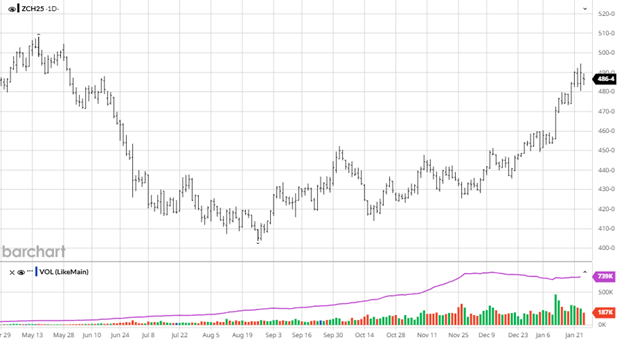

Soybeans’ also got a bump following the January USDA report. The USDA lowered the US crop from 51.7 bu/ac in November to 50.7. The yield cuts worked through to ending stocks but did not completely match as demand numbers were slightly trimmed with harvested acres raised. The Biden administration did not help out the SAF industry on their way out as bean crush plants remain in limbo on its future as a less eco friendly Trump administration takes over. What was projected to be a huge win for soybean growers now is a cloud that you do not know how long it hangs around before it rains. South America’s yields were barely changed with their forecasts now the most important thing to the markets (outside of President Trump starting any trade wars).


Equity Markets
The equity markets have had a volatile end to 2024 and start of 2025 but overall seem to be in a good place as Q4 earnings start to come in. A wave went through the market with Chinese DeepSeek coming out with an opensource AI model that is much cheaper than anything in the US. This caused tech stocks to plummet to start the week with Nvidia losing over 15%. With no immediate tariff action by the Trump administration the market sighed some relief as this administration appears to be taking a more measured approach than in President Trump’s previous term.

Other News
Drought Monitor


Contact an Ag Specialist Today
Whether you’re a producer, end-user, commercial operator, RCM AG Services helps protect revenues and control costs through its suite of hedging tools and network of buyers/sellers — Contact Ag Specialist Brady Lawrence today at 312-858-4049 or blawrence@rcmam.com.

Recap:
” A flare for the dramatics.” That’s how the market was described last week. It was meant for futures but can be easily fit the cash trade most of the year. Here all in or all out mentality drives prices more than supply and demand. The fact that this commodity has been in a range now for over 2 years, but the trade can get chopped up, shows us just how difficult this market is to navigate. At the end of the day, the price always represents value. The main takeaway from last week was that this market is working to redefine the trading range higher. If you look back over the past few weeks, many cash items were back near their lows. That’s not a consolidation higher, but it’s not a confirmation of value. The futures market better defines the overall market as it is a broader indicator of prices and attitudes. Last week we saw a rally of about $40. Yes, it was all in one day and actually all in a matter of minutes, but the fact that it didn’t give it all back tells us that the value area is higher. If all economics remain the same the market has suggested the new value area to be $560 up from $520. The buy zone has moved up. The sell is the premium offered when out of line.
Technical:
It’s hard to find a mirror today’s chart pattern in any markets. The looming gap down to $540 will keep most technicians out of the market. The idea mentioned above of a new value area and how this market trades technically are opposites this week.
The roll has allowed a long algo to trade again. That will be the key to direction this week. That said, with rising open interest in the commercial longs and in the fund shorts, I’m worried more about the downside more than the upside during the holidays. Again, the roll will bring in buying. The best trade of the week is to shut off the computer and come back on January 6th.
Brian Leonard
bleonard@rcmam.com
312-761-2636

Recap:
The market is in trouble. Last week’s trade was the giveback for futures hitting $620. Now what? The trade was out of sync all week. Futures headed lower while the industry was buying. The selling was met with large buy orders all the way down. These opposing dynamics create a bearish atmosphere. Between the industry buying back shorts, the roll and the makeup of the open interest there is much to unpack. Let’s give it a try.
The industry shorts liquidated 1339 contracts in the last reporting period. I have to start by saying that the number is more spec short than actual commercial. My guess is that most of the 1339 contracts were not tied to a cash contract. My point is a spec trade will exit sooner than a hedge trade. The drop in the commercial shorts (specs) will not create an imbalance.
The roll is not typical. Today there are 995 short funds in the market. Many of those may already be sitting in March. They will not be a factor. The likelihood of the market going from a -30 to a -10 this time is small. There might be some creep in, but nothing of substance. This is the time that the market gets some positivity out of the roll. Without it, the market stays under pressure.
The cash market just can’t find a bottom. SYP continues to be the market barometer since the moves are so extreme. SPF can’t move away from that fact. It’s the bitcoin of lumber.
Technical:
The January chart sets off a lot of warning signs. It is not very attractive. A commodity chartist called me today and said, “wow you’re going to 0.” We reviewed the weekly chart only to see more of the same. Lumber futures are not reacting to an extreme RSI or stochastic anymore. It now has a lagging reaction time. Most cash traders would agree that in the cash market the same occurs and the need to retime the buy has to develop. It’s less about the deal. Less about the RSI and more about timing.
A good suggestion for those who have to write a 2025 report for the company is that we may be getting closer to our typical $129 trading range. I think the market is going to be forced sharply higher at some point, but for now set up the parameters or bookends for the year.
Brian Leonard
bleonard@rcmam.com
312-761-2636